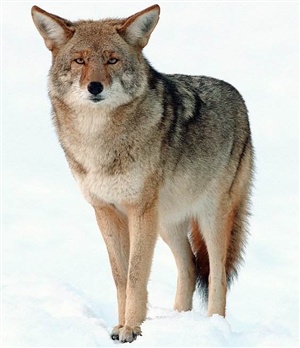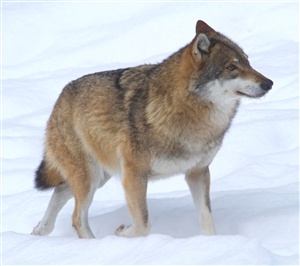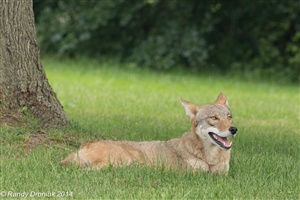Humans have created a new top predator
that is taking over the NortheastHumans are not newcomers when it comes to messing around with nature. While we haven't created Frankenstein's monster yet, what we do transforms the natural world.
One recent example is the creation of the coywolf — a hybrid of the coyote and the wolf that is also known as the Eastern coyote. According to a new article from The Economist, their population seems to have reached more than a million.
These animals have a completely new genetic makeup: Their genes are about one-quarter wolf DNA and two-thirds coyote DNA; the rest is from domesticated dogs. A 2013 study suggests this dog DNA is mostly from a few specific breeds, including German Shepherds and Doberman Pincers.
Human activity likely played a role in the species' creation. As humans cut down wolves' forest homes and hunted down their populations, the lack of available partners for wolves led them to search elsewhere for mates, leading them to coyotes and dogs.
Scientists think this intermixing began with wild wolves in southern Ontario about a century or two ago.
The coywolves' success is astounding scientists. According to The Economist:
The animal’s range has encompassed America’s entire north-east, urban areas included, for at least a decade, and is continuing to expand in the south-east following coywolves’ arrival there half a century ago. This is astonishing. Purebred coyotes never managed to establish themselves east of the prairies. Wolves were killed off in eastern forests long ago. But by combining their DNA, the two have given rise to an animal that is able to spread into a vast and otherwise uninhabitable territory.
Here's the coyote, which traditionally maxes out at 75 pounds and has pointier features, and readily populates cities:
And this is what a wolf looks like. Wolves are usually bigger, weighing in at about 100 pounds, and prefer more wild habitats.
While the grey wolf and the coyote are each other's closest living relatives, the two animals separated evolutionarily 1 to 2 million years ago.
Usually hybrids — even between two closely related species — don't survive as well as their parent species, but the coywolves seem to be an exception. They've only really emerged in force during the last few decades, but they seem to have a few advantages over their parent species.
According to The New York Times' Moises Velazquez-Manoff: "[The coywolf] can be as much as 40 percent larger than the Western coyote, with powerful wolf-like jaws; it has also inherited the wolf's more social nature, which allows for pack hunting."
According to The Economist: "With larger jaws, more muscle and faster legs, individual coywolves can take down small deer. A pack of them can even kill a moose."
These animals are even better fitted to our changing world than we thought, and their proliferation has been more "rapid, pervasive, and transformational than once thought," according to The Economist. The genetic combination of the two animals seems especially well suited to the northern habitat. The wolf genes allow the coyote to take down bigger prey, while the coyote genes let them adapt to cities and other populated areas.
The wolves even follow railroads into cities, making themselves scarce during the day — adopting a nocturnal schedule. They even look both ways before crossing the highway.
Randy Droniuk caught this coywolf lounging in Oakville, Ontario, Canada.
Another reason the animals are so successful could be their wider diet, according to The Economist:




Comments (25)
Sorry had a little chuckle whilst reading as it brought to my mind LITTLE RED RIDING HOOD
enjoyed reading and the pictures.
A remarkably inappropriate sounding name for the largest extant land carnivore, wouldn't y'all agree?
Have you ever noticed the number of comments on blogs of a more serious nature...
Relative to blogs such as, fr'instance...
"What kind of kittens are softest?"
Search -
* Coywolf For Sale *
Attacks in the Eastern U.S. have been reported as "coyote" attacks.
More likely the attacks are by hybrid coywolves.
Despite being a new breed...is it best not to alter a natural predator...here in BC...deer are thriving to the point where they are being culled...we need predators...
So according to Mendel's Chromosome Theory of Heredity, oneday if a Coywolf has 12 babies, it might be 3 Wolves, 8 Coyotes and 1 Dog. Interesting, isn't it?
Now, I wonder about a Werewolf.. what intermixes with what?
Are you sure you don't need them?...lol...
News you can use, IME their ribs are thin and if a human can manage to wrap an arm below/behind their shoulders with one arm, while maintaining control of the head by grabbing the scruff of the neck with the other arm, about 30 pounds of pressure applied around the ribs is sufficient to prevent the Canis Rufus from breathing and is soon followed by unconsciousness, and about 60 pounds will cause the ribs to crack and break which usually removes the animal as a threat. It should be anticipated that the Canis Rufus will be resistant to your acquiring the needed positioning for such subjugation and some blood loss is to be expected.
But you should not expect a DNA mixed animal to unmix, ever.
Here you go...lol...
First, does that mean Mendel's Theory only apply to certain DNA?
Second, how would you certainly know if those mentioned animals were not heredited from one? An extreme environment could cause DNA mutation, no? That's why the intermix is possible, no?
I guess, the lack of an underlying mechanism for heredity was one of problems Darwin had in his theory of evolution..
If you can...watch this...
DNA is information which might be thought of as the blueprint and operating manual for an organism & it's various cells.
And the DNA is located within the cells.
Remember, DNA is ONLY information that provides instructions a cell needs to reproduce & function.
Again, think of DNA as a blueprint.
It connot, of itself, make a cell, nor perform any cellular function, any more than a blueprint, of itself, can construct a factory, or carry on the work of a factory.
So, in a modern version of "the chicken or the egg" riddle...
Which came first?
DNA?
Or the cell?
How?
According to Yahoo! Answers, the BEST ANSWER to the DNA/Cell riddle is "No one knows..."
If you search the question, there is much written on the subject...
Can't really say there's an answer, though.
Some cop out by saying protein, RNA, or something like "proto-DNA" came first.
Fine. Then the implication is that these things arranged themselves (
Problem: Even if DNA managed to fabricate itself (
Others claim a "proto-cell" like thing appeared first and developed DNA to function & reproduce. (
Fine. Then the implication is that inert matter began assembling itself
Problem: Without the DNA...a COMPLETE set of DNA with information for reproduction & functioning, even a complex cell, or pre-cell thingy, is just a bunch of stuff that spontaneously assembled itself (
Have fun, y'all!!
You may submit your solution to Yahoo! Answers.
Makes that "chicken & egg" poser seem kinda easy, eh?
I hate seeing it slip into Page 2 Blog Oblivion.